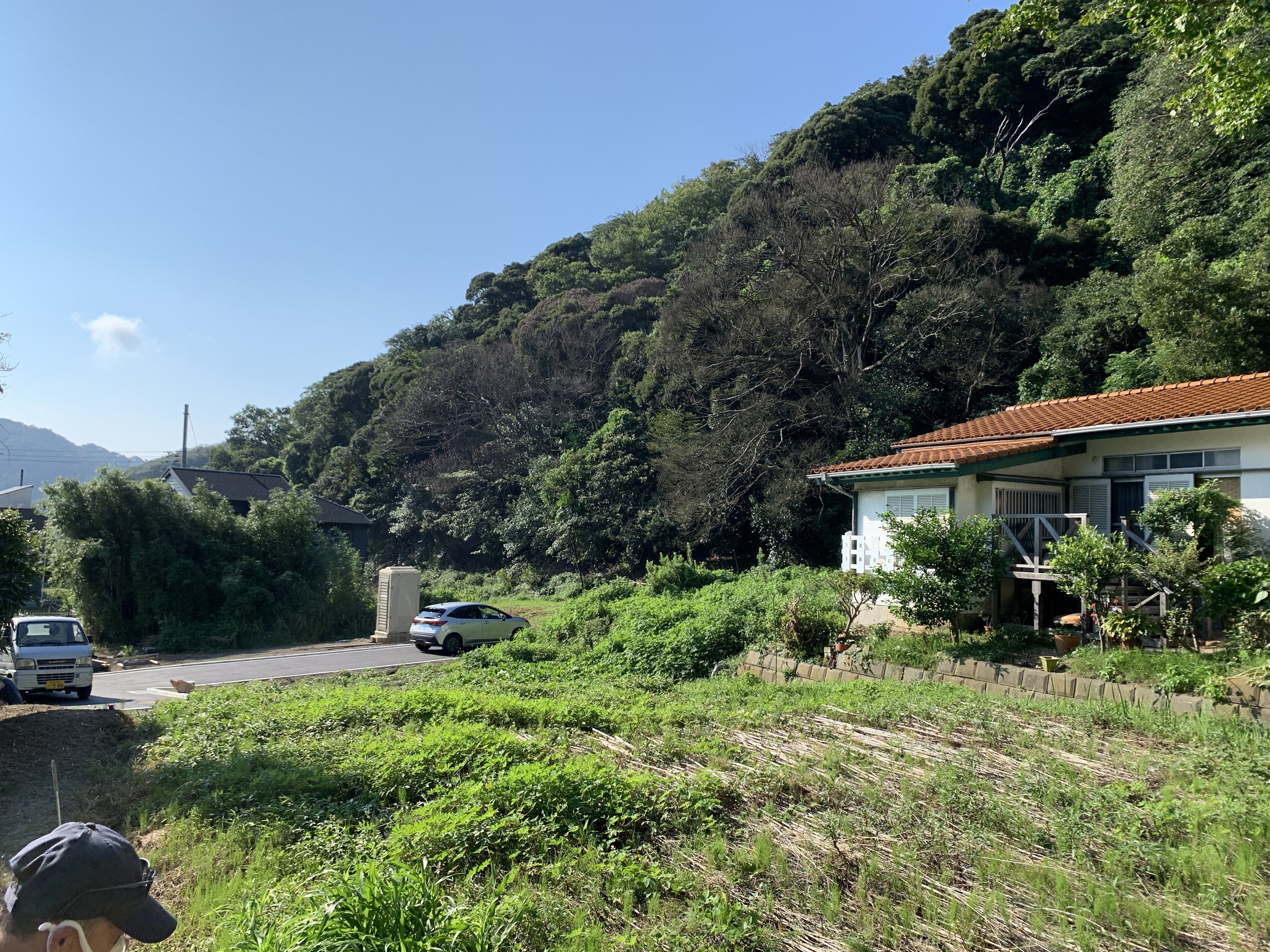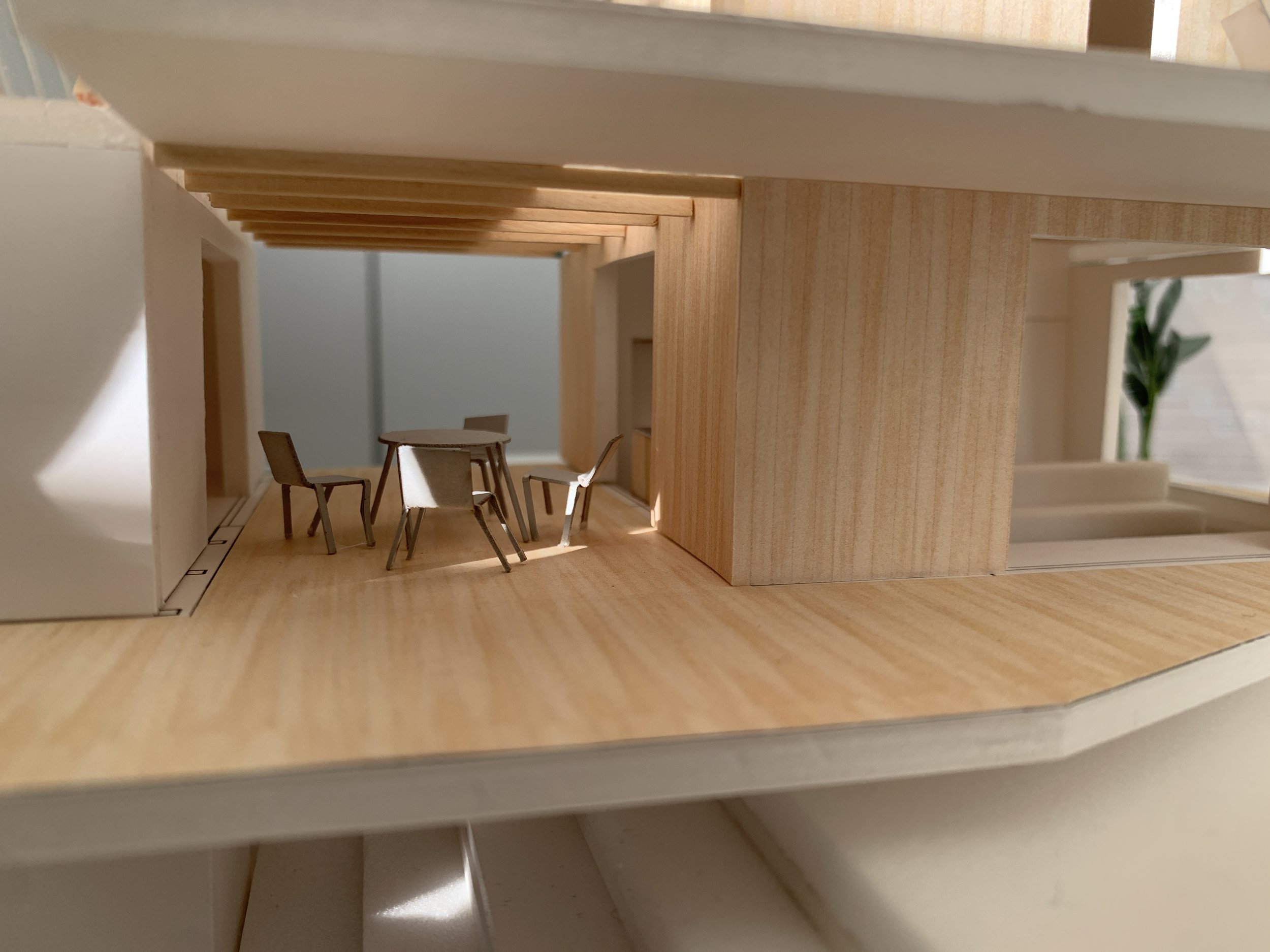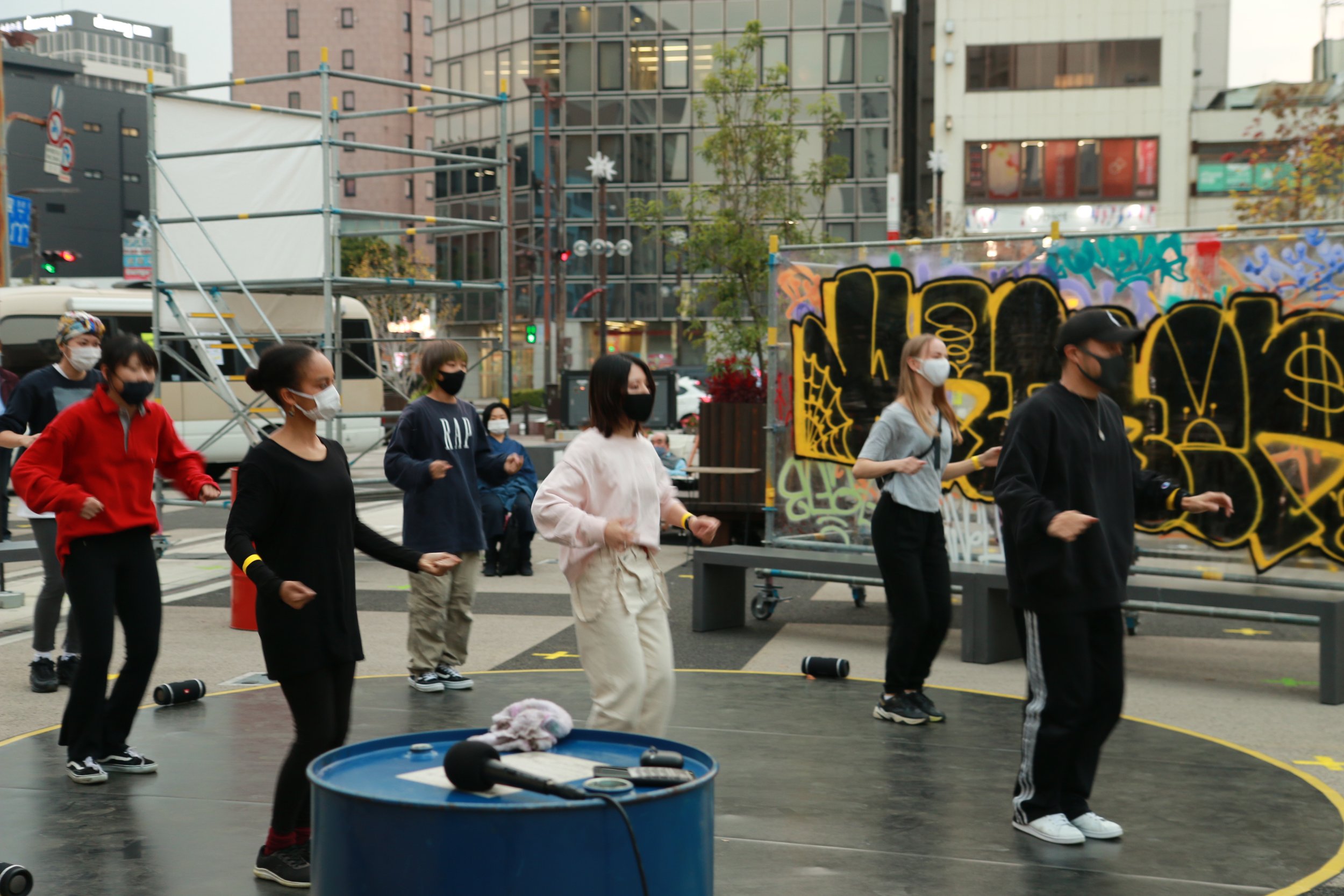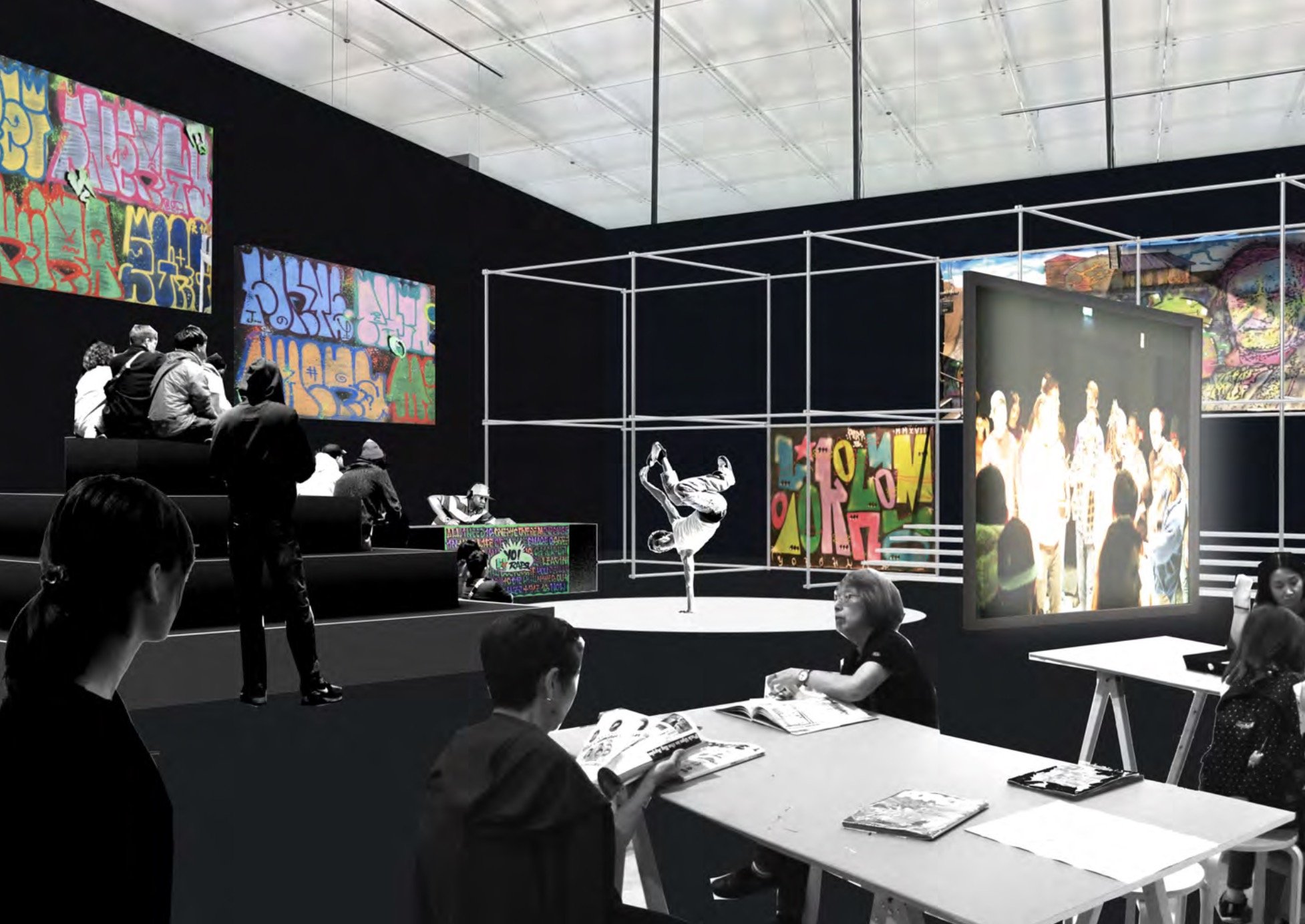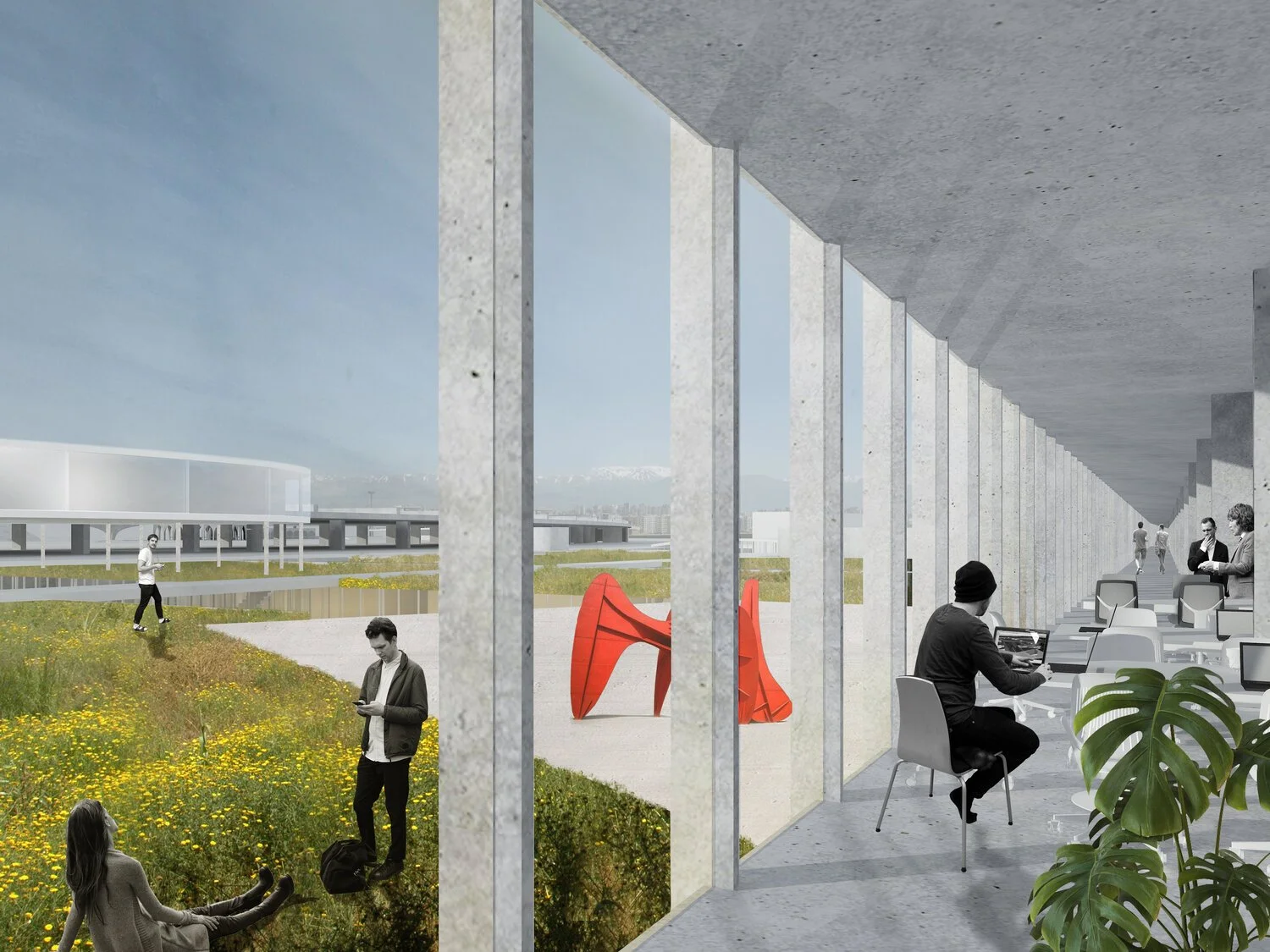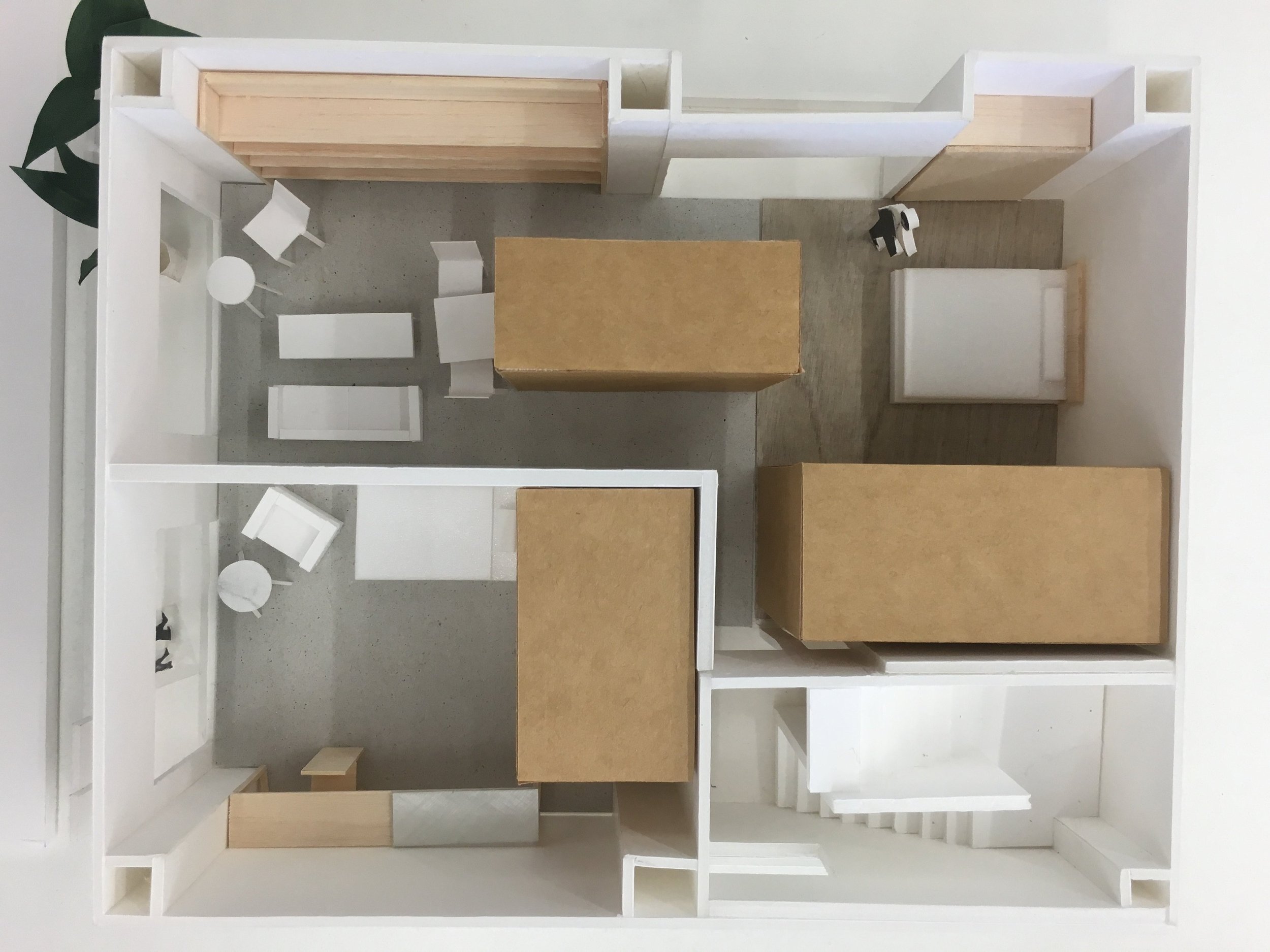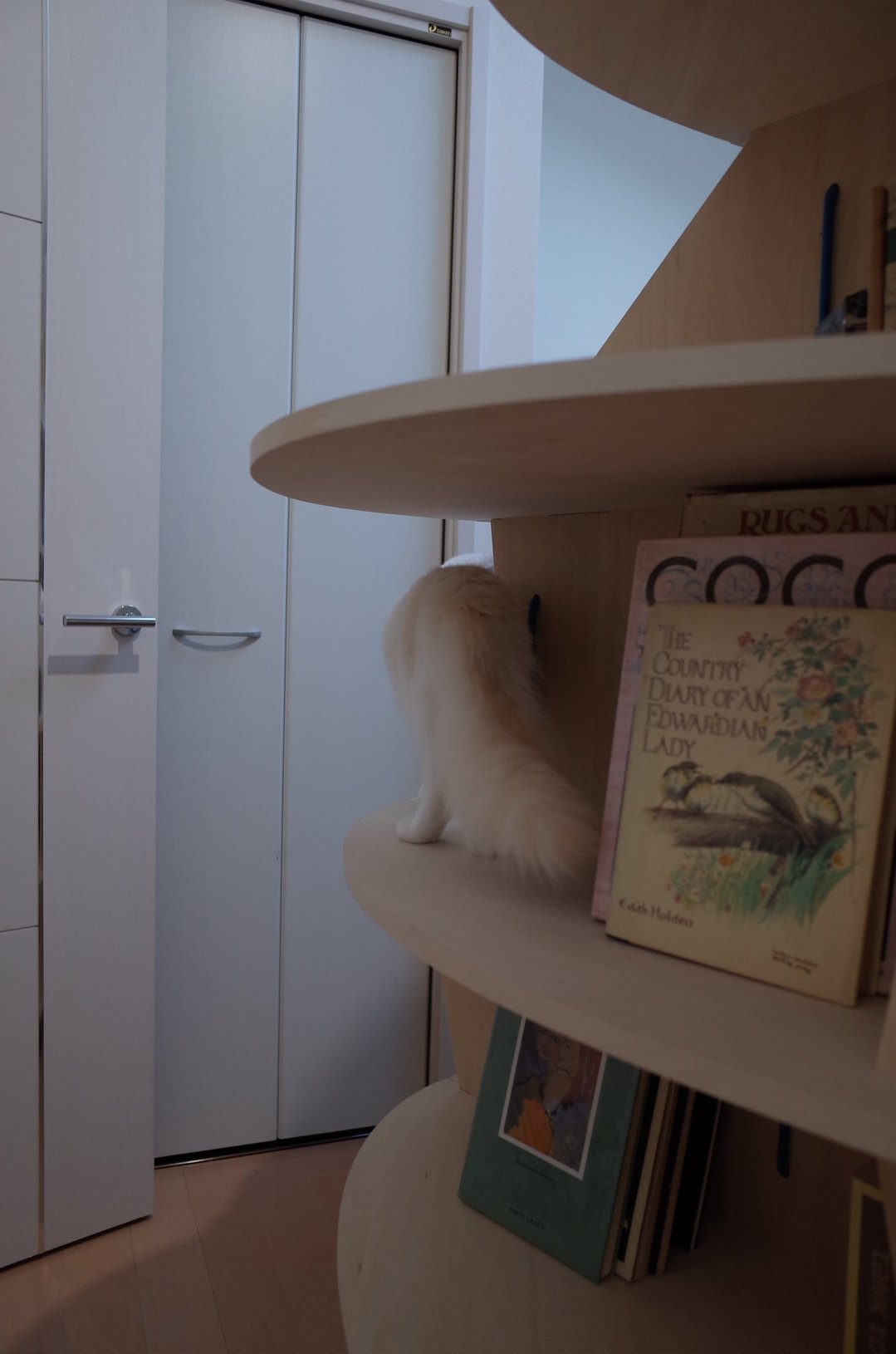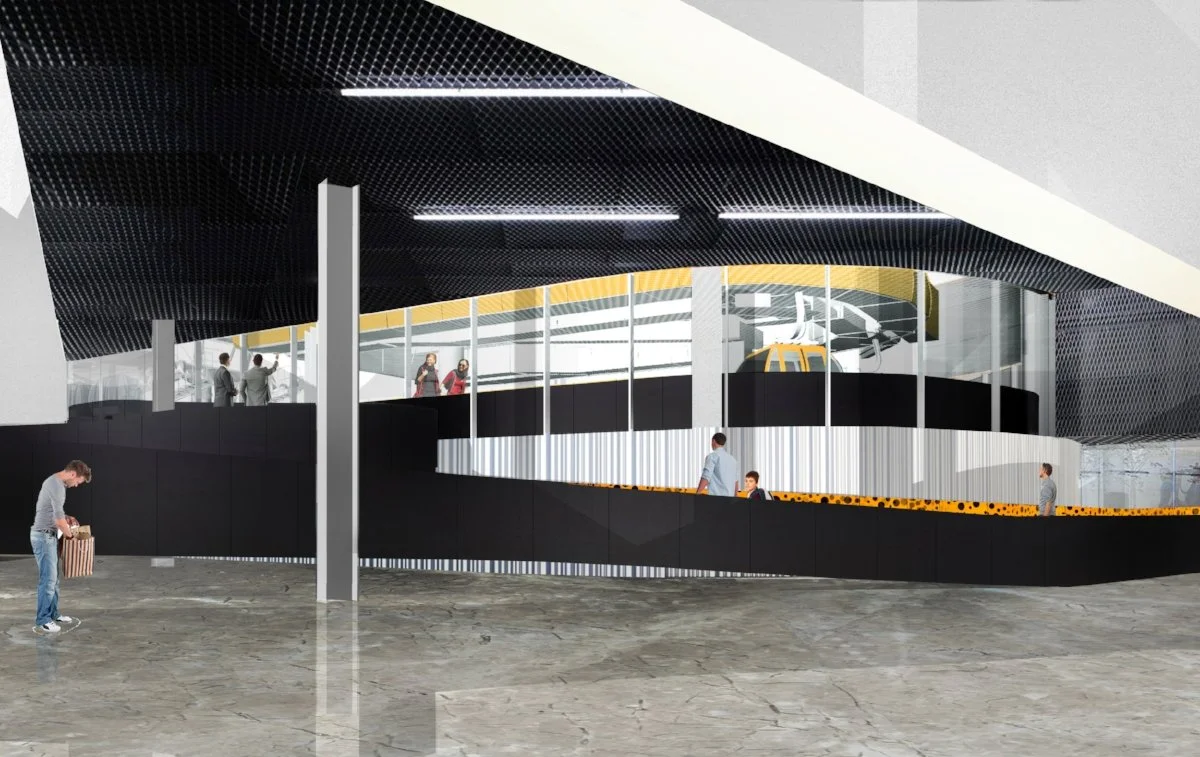TRACK / TRUCK
-
Location: Shodo Island, Japan
Program: Food Truck / Pavilliion
Area:
Status: Completed 2022
Team: Keigo Kobayashi
Collaborator: Food & The City Research Group (Ko Nakamura, Mamiko Miyahara), Waseda Univ. / Saga University / Mossaic Design Inc.
NoRA was commissioned in 2017 to conduct a research and brief definition for a multi-functional cultural facility to support the transformation of Kish Island in Iran from a shopping destination to a creative city. Seizing the opportunity of Kish’s strong interface with both mainland Iran and the rest of the world, the creation of a singular platform that consolidates all functions inherent to Art will drive the production, dissemination and exposure of Iranian indigenous arts & crafts making them part of the global contemporary scene.As a result of 40+ years of targeted policies towards achieving a consumerist paradise, Kish Island is widely – and perhaps exclusively - known as “the” shopping and entertainment destination of Iran, heavily supported by domestic tourism. Today however, the growing national and regional competition in the tourism sector renders it indispensable to re-assess the island’s socio-economic and geographic potentials in an effort to deploy a more integrated vision for the future of Kish, one that would transform it into a 'creative city' as announced by the Kish Free Zone Authority.
NoRA’s research investigates the potentials of the island and proposes a vision for a diversified economy and a renewed attractiveness for visitors, domestic and foreign, through the – so far under-exploited - vector of Culture and the Indigenous Arts. One proposed architectural manifestation to materialise that vision is through the construction of an Art Foundation where production, education, exhibition, auction, storage... all intersect.
IZUNOKUNISHI DANCE CENTER
-
Location: Izu, Japan
Program: Traditional Performance Center
Area: 900m2
Status: Competition
Team: Keigo Kobayashi
Collaborator: Takuya Hosokai ArchitectsThis building is a multifunctional facility designed to preserve and promote the traditional performing arts of Izunokuni City in Japan. It features a main public hall, a stage, rehearsal rooms, and exhibition spaces. The project is expected to reflect the uniqueness of the region by incorporating its rich natural environment and local cultural traditions.
The proposed scheme consists of a series of square volumes of varying sizes, each serving different functions. The largest square is designed as an outdoor stage where various town events can take place. The sloped roofs of the volumes open in different directions, creating a roofscape that complements the town's skyline while providing views of the surrounding mountains and landscape from the interior.
この建物は、伊豆の国市の伝統芸能を保存し、地域内外に発信するための複合施設です。主要な機能として、公共ホールを中心に、舞台、練習室、展示スペースを備えています。伊豆の豊かな自然環境と地域の伝統文化を取り入れることで、地域性を感じさせる建物となることが求められています。
本提案は、異なる機能を持つさまざまなサイズの正方形のボリュームの連続で構成されており、最も大きな正方形は、町のさまざまなイベントが行われる野外ステージとして設計されています。ボリュームの傾斜屋根は異なる方向に開いており、町のスカイラインに調和する景観を生み出すとともに、内部からは周囲の山々や風景の眺めを提供します。
GARAGE HOUSE
-
Location: Tokyo, Japan
Program: Housing
Area: 109㎡
Status: Proposal 2020
Team: Keigo Kobayashi
Collaborator: K2LAB, Haruka UemuraThis house, designed for a family of four, is situated on a corner of the parents' property, providing parking for two vehicles—one for the family and one for the parents. To maintain daily interaction while preserving a respectful distance, the house incorporates a semi-open zone under a single roof, serving as a buffer between the two households. Within this zone, three enclosed spaces are strategically placed: one for gatherings, one for solitude, and another for bathroom functions.
ガレージの家
この家は4人家族のために設計されており、親の土地の一角に位置し、家族用と親用の2台分の駐車スペースを提供しています。日常的な交流を保ちながらも適切な距離感を保つため、家屋の下に半開放的な空間を設け、両世帯の緩衝地帯としています。その空間内には、集まるためのスペース、静寂のためのスペース、そして水回りのためのスペースが配置されています。
SHIBUYA RE-MIX BUILDING
-
Location: Tokyo, Japan
Program: Office/Gallery/Shop/Event Space, 1,760 m2 Total
Status: Proposal 2017
Team: N/A
Collaborator: N/AUnlike other buildings in the area, which typically consist of offices on the upper floors and commercial spaces on the lower levels, this project presents a unique opportunity by incorporating a gallery space between the upper office floors and the lower commercial areas. In most buildings, the offices and commercial spaces function independently, with little to no interaction. However, in this project, the gallery serves as a vital connector between the two levels.
The gallery space is accessible to both office workers and shoppers, and when not used for exhibitions, it can be repurposed as an extension of the offices or the commercial space. Architecturally, the building's form complies with setback regulations while providing terraces for the gallery and office spaces.
このプロジェクトは、一般的な雑居ビルのように下層階に商業スペース、上層階にオフィスといったものとは異なり、下層の商業階と上層のオフィス階との間にギャラリースペースが設置されるという、特徴のあるビルになります。通常、商業スペースとオフィスは互いに関係を持たないのが一般的ですが、このプロジェクトでは、このギャラリースペースを上下機能を編み合わせる重要な要素として捉え、空間としても層を跨いだ連続性をもったデザインとしています。
またギャラリースペースは、オフィスの従業員と下層の店舗の利用者の両方に開かれており、展示が行われていないときには、オフィスや店舗の拡張スペースとして使用することが可能です。建物の形状はセットバック規制に対応しながら、ギャラリーやオフィスのためのテラスを提供し、また大きくとられた開口は密集地の中でも視線の抜けを確保するようにデザインされています。
KUROISO LIBRARY COMPETITION
-
Location: Nasu, Japan
Status: Competition
Program: Library, 4,500 m2 Total ,2016
Team: Keigo Kobayashi
Collaborator: Haruka Uemura, Takuya HosokaiLike many rural towns, Kuroiso is a place where heavy reliance on vehicles shapes the lifestyle of its residents. To design a new library between the railway station and its parking area, we propose creating a "sports park with books." The main sections of the library are elevated, allowing for an open field beneath that can be used for various activities, including sports courts, event spaces, and other library programs.
Libraries, which once served as repositories and hubs of knowledge for citizens, have now become one of the few public spaces where a diverse range of people can freely spend time without any cost. For many, they have transformed into "third places," where one can linger without necessarily choosing a book. However, as books increasingly become mere displays, the unique atmosphere of traditional libraries, surrounded by books, is gradually being lost. In response, this project deliberately separates the third-place concept from books while enhancing its public nature by incorporating a variety of functions. The goal is not only to nurture intellectual growth but also to promote physical health, creating a space that fosters a healthy lifestyle where multiple generations can interact, particularly in a town experiencing rapid aging.
多くの地方都市と同様に、黒磯は車への依存度が高い町です。本プロジェクトでは、鉄道駅とその駐車場の間に新しい図書館を設計する上で、私たちは「本のあるスポーツパーク」を提案しています。図書館の主要な部分は地上から持ち上げられ、その下にはスポーツコートやイベントスペース、子供のための空間やその他の活動空間などが広がるオープンフィールドとしています。一方で2階は、本を選び、静かに読むための空間として、世界中の著名な図書館のホールの形状を集めた、本に特化した空間としています。
かつては市民のための知識の保管と共有の役割を担った図書館も、いまや多様な人々が無料で佇むことが出来る数少ない公共機能の一つであり、大半の人は本を選ばずとも自由に時間を過ごすことのできるサードプレイスとなっています。その一方で、本がディスプレイ化しつつあり、従来の本に囲われた図書館独特の空間は失われつつあります。そこで、このプロジェクトでは、あえてサードプレイス的空間を本から切り離しつつ、その公共性により多様な機能を付加することで、知性を育むだけでなく、身体の健康も促進し、急速に高齢化が進む町において、多世代が交わる健康的なライフスタイルを育んでいくきっかけの場となることを期待しています。
YAGUMO APARTMENT
-
Location: Tokyo, Japan
Program: Apartment Complex
Status: Proposal 2022
Team: N/A
Collaborator: N/A
Octo-cloud ApartmentThis project involves a three-story apartment building in Tokyo, partially occupied by housing units for the owner’s family. The design minimizes the building’s impact on the streetscape by incorporating stepped offsets, which also serve as semi-enclosed terraces for the tenants. The areas for the tenants and the owner’s family are separated both in plan and section, with the owner’s family retaining some of the original garden space at the southern end of the plot.
このプロジェクトは、オーナー家族がその一部に住まう東京の3階建てアパートです。ステップ状にオフセットしたボリュームを用いることで通りへの圧迫感を軽減しつつ、テナントユニット用のテラスとしても機能します。テナントのエリアとオーナー家族エリアは、平面と断面の両方で分離されており、オーナー家族は元の土地にあった庭の一部を保つことができるように計画しています。
RULE EXHIBITION
-
Location: 21_21 Design Site, Tokyo
Program: Exhibition Installation
Area:
Status: Completed 2021
Team: Keigo Kobayashi
Collaborator: Daniel Wetzel (Rimini Protokoll), Miyuki Tanaka, Shunya Hagiwara, N sketch Inc., Luftzug, UMA/design farm, Kazuyuki Nakamura (Meiji University), Kyle Yamada, Fumiko Toda
This is the spatial design for an interactive exhibit titled "Who else if not you?" that was part of the "Rule? Exhibition" held at 21_21 Design Sight (July–November 2021). The exhibit invites visitors to answer a series of questions, transforming them into data samples that contribute to the overall statistics. It illustrates the paradoxical situation where each participant is both the central figure on stage and merely a single data point in a larger statistical graph. This concept is visually expressed through a circular stage, with a pie chart view captured from above. The room, typically accessed via stairs, is reimagined as a backstage area leading to the stage itself.
HOUSE IN ISSHIKI
-
Location: Isshiki, Kanagawa
Program: Family House
Area: 200m2
Status: Design Proposal
Team: Keigo Kobayashi
Collaborator: Waseda Univ. K2LABDesign proposal for a family who bought a land near Isshiki Beach in Kanagawa, Japan. Since the house was to be shared between the parents and the daughter’s family, the house is designed into two small volumes connected by semi-exterior decks. On the third floor, a bathroom that also serves as a greenhouse is included, offering an only view of the sea. The ground level features a pilotis space that functions as both a garage and a multipurpose area. This space is intentionally left undefined, allowing for a variety of uses, such as storing marine sports equipment, displaying artwork from acquaintances, or hosting a market.
WAGNER PROJECT OITA 2020
-
Location: Oita city, Japan
Program: Scenography Design
Area:
Status: Completed 2020
Team: Keigo Kobayashi, Kentaro Nomura
Collaborator: listed below
“Wagner Project” is a 5-day “theater” that combines Richard Wagner’s opera “The Meistersinger of Nuremberg” with street culture such as hip-hop and rap. The project is a collaborative project with Theater Director/Artist Akira Takayama / portB. Kobayashi Lab is in charge of spatial composition.
Following Yokohama KAAT, Berlin, and Frankfurt, this time Oita City ‘festival square’ was realized as a temporary city. In Oita, the venue is a part of the actual city, and the public nature of the plaza has been ensured, so instead of taking a dichotomous approach as in the previous cases, we considered the ideal place for a city that is more integrated into the city or a city that moves for a short period of time. Referring to Archigram’s concept of Instant City as a design concept, it gathers all the mobile and temporary elements of an existing city and places them in a square. We tried to eliminate new elements as much as possible, and tried to form the field by the arrangement relation and the utilization method of various things.With COVID, a distance mark every 2 meters is set in the whole square. In addition, by using different venue layouts in the two scenes of “Hare” and “ke,” and by appropriately moving movable elements according to the timetable, it was examined to produce the original scenery of the square which can be related to various acts with anyone and anywhere.
General Direction: Akira Takayama
Performance: Wagner Crew
TEACHERS: Hiro Ekaki, Darthraider, Snipe1, NAOYA (ex. ZOO), Pocchomkin (Gaki Ranger), Ossman, Meteor, Kenchinmin, MOTOKI, Bassons, Akira Takayama
Music Director: Hiroshi Egaitsu
Spatial Design: Keigo Kobayashi
Graffiti: Snipe1
Assistant Director: Saki Tanaka
Coordination: NARITO RIDER
Graphic Design: Kota Abe
Stage Management: Yasushi Tahara (T.C.D. Office LLC)
Media Direction: Shintaro Wada
Media Team: Tomoko Sato, Nozomi Sawamoto, Takahiro Sato, Chieko Asakura, Sohn Kyesung, Kumiko Kasashima
Spatial Design Assistant: Haruka Uemura
Spatial Design Team: Masayoshi Waku, Natsumi Kawami, Kentaro Nomura, Konstancja Kusiak, Paiva Euridice, Shinpei Ogawa, Kotomi Kameda, Ryosei Takenaka, Yuto Tanada
Production: Fumiko Toda
Sound System: PANORAMA
Operations Support: T.C.D. Office LLC
Miyuki Tahara, Aoi Makino, Nao Otsu, Masaaki Sato, Ken Hiura, Takeaki Seiyu, Akira HirakawaVolunteers: Rui Kido, Ryo Iwao, Yusaku Abe, Kenichiro Nagata, Ayawa Matsuda, Haruna Imamura, Renge Tachikawa, Akura Seno, Tomoko Iwagaki, Yuichiro Abe, Hiroshi Tahara, Takayuki Haradaguchi, Tomoko Furuyama, Tomie Kuwahara, Keiji Furuyama, Hiromi Goto
FOOD: Damaya Curry, Sunrise Cafe, Tasaki Liquor Store, PIZZA LINDA, Rojiura Sour
Collaborations: Tokyo University of the Arts Graduate School of Film and New Media, Waseda University Graduate School of Creative Science and Engineering, Department of Architecture (Keigo Kobayashi Lab), RAM Association, Kohonya honkbooks, MONTANA COLORS JP
Planning & Production: PortB, Port Urban Research Center
WAGNER PROJECT KANAZAWA
-
Location: Kish Island, Iran
Program: Research on Potentials for Cultural Development on Kish Island
Area:
Status: Research Completed 2017
Team:
Collaborator: N/A
NoRA was commissioned in 2017 to conduct a research and brief definition for a multi-functional cultural facility to support the transformation of Kish Island in Iran from a shopping destination to a creative city. Seizing the opportunity of Kish’s strong interface with both mainland Iran and the rest of the world, the creation of a singular platform that consolidates all functions inherent to Art will drive the production, dissemination and exposure of Iranian indigenous arts & crafts making them part of the global contemporary scene.As a result of 40+ years of targeted policies towards achieving a consumerist paradise, Kish Island is widely – and perhaps exclusively - known as “the” shopping and entertainment destination of Iran, heavily supported by domestic tourism. Today however, the growing national and regional competition in the tourism sector renders it indispensable to re-assess the island’s socio-economic and geographic potentials in an effort to deploy a more integrated vision for the future of Kish, one that would transform it into a 'creative city' as announced by the Kish Free Zone Authority.
NoRA’s research investigates the potentials of the island and proposes a vision for a diversified economy and a renewed attractiveness for visitors, domestic and foreign, through the – so far under-exploited - vector of Culture and the Indigenous Arts. One proposed architectural manifestation to materialise that vision is through the construction of an Art Foundation where production, education, exhibition, auction, storage... all intersect.
WAGNER PROJECT OITA 2022
-
Location: Oita, Japan
Program: Temporary Square
Area:
Status: Completed 2022
Team:
Collaborator: Port B
NoRA was commissioned in 2017 to conduct a research and brief definition for a multi-functional cultural facility to support the transformation of Kish Island in Iran from a shopping destination to a creative city. Seizing the opportunity of Kish’s strong interface with both mainland Iran and the rest of the world, the creation of a singular platform that consolidates all functions inherent to Art will drive the production, dissemination and exposure of Iranian indigenous arts & crafts making them part of the global contemporary scene.As a result of 40+ years of targeted policies towards achieving a consumerist paradise, Kish Island is widely – and perhaps exclusively - known as “the” shopping and entertainment destination of Iran, heavily supported by domestic tourism. Today however, the growing national and regional competition in the tourism sector renders it indispensable to re-assess the island’s socio-economic and geographic potentials in an effort to deploy a more integrated vision for the future of Kish, one that would transform it into a 'creative city' as announced by the Kish Free Zone Authority.
NoRA’s research investigates the potentials of the island and proposes a vision for a diversified economy and a renewed attractiveness for visitors, domestic and foreign, through the – so far under-exploited - vector of Culture and the Indigenous Arts. One proposed architectural manifestation to materialise that vision is through the construction of an Art Foundation where production, education, exhibition, auction, storage... all intersect.
RE-PLAY / AFRICAN CROSSROADS
-
Location: Rabat, Morocco
Program: Research
Area: N/A
Status: Research Completed 2019
Team:
Collaborators: Stimuleringsfonds Creative Industries
RE-PLAY is a Research on Play and/in the City that discusses the broader definition of the word play : it encompasses the notions of engaging in an activity for enjoyment and recreation, being cooperative, participate but also as a noun, play means the space in or through which a mechanism can or does move=> a room for manoeuvre, a margin, leeway.The booklet is an image-based compilation of contrasting practices or theories about Play in the urban environment (Huizinga, Lefebvre, Constant, van Eyck, Matta-Clark, Corbusier and others) accompanied by a question, quote or statement that will invite the visitor to reflect further on the topic and form their own conviction.
RE-PLAY was presented at the 1st Edition of African Crossroads that took place in December 2018 in Marrakech.
THE HAGUE INTERNATIONAL QUARTER
-
Location: Kish Island, Iran
Program: Research on Potentials for Cultural Development on Kish Island
Area:
Status: Research Completed 2017
Team:
Collaborator: N/A
NoRA was commissioned in 2017 to conduct a research and brief definition for a multi-functional cultural facility to support the transformation of Kish Island in Iran from a shopping destination to a creative city. Seizing the opportunity of Kish’s strong interface with both mainland Iran and the rest of the world, the creation of a singular platform that consolidates all functions inherent to Art will drive the production, dissemination and exposure of Iranian indigenous arts & crafts making them part of the global contemporary scene.As a result of 40+ years of targeted policies towards achieving a consumerist paradise, Kish Island is widely – and perhaps exclusively - known as “the” shopping and entertainment destination of Iran, heavily supported by domestic tourism. Today however, the growing national and regional competition in the tourism sector renders it indispensable to re-assess the island’s socio-economic and geographic potentials in an effort to deploy a more integrated vision for the future of Kish, one that would transform it into a 'creative city' as announced by the Kish Free Zone Authority.
NoRA’s research investigates the potentials of the island and proposes a vision for a diversified economy and a renewed attractiveness for visitors, domestic and foreign, through the – so far under-exploited - vector of Culture and the Indigenous Arts. One proposed architectural manifestation to materialise that vision is through the construction of an Art Foundation where production, education, exhibition, auction, storage... all intersect.
TRIPOLI KNOWLEDGE & INNOVATION CENTRE
-
Location: Kish Island, Iran
Program: Research on Potentials for Cultural Development on Kish Island
Area:
Status: Research Completed 2017
Team:
Collaborator: N/A
NoRA was commissioned in 2017 to conduct a research and brief definition for a multi-functional cultural facility to support the transformation of Kish Island in Iran from a shopping destination to a creative city. Seizing the opportunity of Kish’s strong interface with both mainland Iran and the rest of the world, the creation of a singular platform that consolidates all functions inherent to Art will drive the production, dissemination and exposure of Iranian indigenous arts & crafts making them part of the global contemporary scene.As a result of 40+ years of targeted policies towards achieving a consumerist paradise, Kish Island is widely – and perhaps exclusively - known as “the” shopping and entertainment destination of Iran, heavily supported by domestic tourism. Today however, the growing national and regional competition in the tourism sector renders it indispensable to re-assess the island’s socio-economic and geographic potentials in an effort to deploy a more integrated vision for the future of Kish, one that would transform it into a 'creative city' as announced by the Kish Free Zone Authority.
NoRA’s research investigates the potentials of the island and proposes a vision for a diversified economy and a renewed attractiveness for visitors, domestic and foreign, through the – so far under-exploited - vector of Culture and the Indigenous Arts. One proposed architectural manifestation to materialise that vision is through the construction of an Art Foundation where production, education, exhibition, auction, storage... all intersect.
RHIZOMATICS INTERIOR
-
Location:
Program:
Area:
Status:
Team:
Collaborator:
Fake text Fake textFake textFake textFake textFake textFake textFake textFake textFake textFake textFake textFake textFake textFake textFake textFake textFake textFake textFake textFake textFake textFake textFake textFake textFake textFake textFake textFake textFake textFake textFake textFake textFake textFake textFake textFake textFake textFake textFake textFake textFake textFake textFake textFake textFake textFake textFake textFake textFake textFake textFake textFake textFake textFake textFake textFake textFake textFake textFake textFake textFake textFake textFake textFake textFake textFake textFake textFake textFake textFake textFake text
MOROCCO MINISTERY OF CULTURE AND COMMUNICATION HQ
-
Location: Rabat, Morocco Status: Competition Program: Office, Conference Centre, Public Archives, Restaurant
11,340 m2 TotalLe nouveau Ministère de la Culture s’insère dans le contexte du quartier administratif de Hay Riad selon une écriture sobre et épurée. La silhouette du bâtiment se détache de par sa volumétrie minimale.
L’utilisation de deux types de vitrage en façade donne au bâtiment une impression de lévitation avec une partie supérieure enveloppée de verre sérigraphié d’apparence plutôt translucide qui “flotte” au-dessus d’une base transparente.
Les retraits imposés par le plan d’aménagement sont ici pris au compte du projet et lui insufflent une certaine dynamique dans sa volumétrie par ailleurs rationnelle.
IKEBUKURO VERTICAL VILLAGE
-
Location: Tokyo, Japan
Program: Housing / Cafe / Garden
Area:
Status: Proposal 2018
Team: N/A
Collaborator: N/AThis project was a design proposal for a small tenant building in the Ikebukuro area of Tokyo. The owner sought a complete renovation of the building, which includes a ground-level shop and apartment units.
We proposed a holistic concept where tenants could use the café/restaurant on the ground floor as a communal kitchen, while the rooftop could be transformed into a community garden. The produce grown in the garden could be used in the café/restaurant, while natural waste from the residents could be composted to nourish the garden.
In urban apartment complexes, neighbors rarely interact with one another. We envisioned this project as a small ecological system, fostering connections between food, energy, and the community.
Within the residential units, we proposed the installation of compact, autonomous volumes that serve as partitions, bathrooms, storage spaces, and kitchens. Rather than extensively renovating each room, this "architecture within architecture" approach minimizes both cost and time. In Japan, there are currently 9 million vacant housing units. We believe this approach could transform these empty spaces into a wealth of opportunities.
本プロジェクトは、東京の池袋エリアにある小規模なテナントビルのデザイン提案でした。オーナーは、1階の店舗とその上の賃貸アパートを含む建物全体の改修を希望していました。
私たちは、アパートの住民が1階のカフェ/レストランを共用のキッチンとして利用し、屋上をコミュニティガーデンとして活用する、包括的なアイデアを提案しました。ガーデンで育てた野菜は1階のカフェ/レストランで使用され、住民から出る生ごみはコンポストを通じてガーデンに還元される仕組みです。
都市部のアパートでは、住民同士が隣人と関わる機会はほとんどありません。このプロジェクトでは、食、エネルギー、そして住民同士の関係を育む小さなエコシステムを想像しました。
一方で、住居内では、コンパクトで自律的なボリュームを配置し、これを仕切りやバス、収納、キッチンとして活用することを提案しました。各部屋を大規模に改装するのではなく、「建築内の建築」という手法により、改修のコストと時間を最小限に抑えることが可能となります。現在、日本には900万戸もの空き家があります。この「建築内の建築」という方法は、こうした余白を新たな可能性の空間へと変えることができると考えます。
MEGURO ROOM RENOVATION
-
Location: Tokyo, Japan
Program: Interior Renovation
Area: 50㎡
Status: Completed 2021
Team: N/A
Collaborator: N/A
In Japan, the majority of apartment layouts are nearly identical. This uniformity arises from several factors, including similar plot sizes, cost-effective concrete beam spans, regulations on natural light, and efficient plumbing designs.This 50m² apartment was no exception. Upon entering, the bathrooms are located on one side of the hallway, with a bedroom on the other. At the end of the corridor is the kitchen and dining area, which is shared with the living room. A narrow terrace runs along the living room.
The renovation was designed for a family of three, necessitating the creation of a larger spatial illusion. Instead of pushing all enclosed functions to the outer walls, we positioned a single volume—containing the bathroom, closets, fridge, and laundry—at the center of the apartment. This design creates a looped circulation, where a blind spot at the far end always generates a sense of depth and continuity.
Large sliding panels along the living room can transform the layout in various ways, creating bedrooms when needed or converting the utility area into a single, enclosed space. We have also envisioned that, when the children grow older, temporary wall can be installed in part of the loop, allowing for the creation of two separate bedroom.
日本では、大半のアパートの間取りがほぼ同じです。この均一性は、敷地条件の類似性、経済的なコンクリート梁のスパン、採光規制、効率的な配管設計など、いくつかの要因に起因しています。
この50㎡のアパートも例外ではなく、玄関を入ると廊下の片側に水回り、もう一方に寝室があり、廊下の奥にはリビングと共有されたキッチンとダイニングが配置されています。リビングからは細長いテラスへアクセスできます。
本リノベーションは、3人家族を想定して設計されており、より広く感じられる空間を作る必要がありました。そこで、すべての閉じた機能を外壁沿いに追いやるのではなく、バスルーム、クローゼット、冷蔵庫、ランドリーを含む単一のボリュームをアパートの中央に配置しました。この設計により、家全体がループ状の動線となり、ループの遠端に常に死角が生まれることで、奥行きと連続性を感じることが出来ます。
リビングに沿った大きな引き戸は、必要に応じてレイアウトを変更でき、寝室を作ることや、ユーティリティスペースを単独の閉じたゾーンに分離することが可能です。また、将来的に子供が成長した際には、ループの一部に仮設の壁を設置することで、2つの異なる寝室空間を生み出すことができる想定としています。
YAMAYA RESTAURANT COMPETITION
-
Location: Fukuoka, Japan
Program: Restaurant
Status: Compitition 2021
Team : N/A
Collaborator: N/A
九州は食材の宝庫であり、全国供給量の上位を占める野菜や豊富な精肉類、魚介類が特徴です。この豊かさは、九州特有の山々と海の近接した自然環境や、活発な火山活動、地殻変動が育んだ独自の地質に起因しています。その多様な土壌は、美しい焼物の器も生み出しています。本計画案では、こうした九州の食文化を生み出し、育んできた土壌のような、プラットフォームとしての場を提案しています。具体的には、地域の歴史を物語る既存の建物や庭を活かし、更新しながら保存することで、地域の財産となるような場の創出を目指します。既存の母屋については、一部の減築を除き、原形を保ちながら新素材で覆い更新します。主にメインのキッチンになります。木造アパートは、大きく改変し、吹き抜け空間を設けて、バーの他イベントや展示を行える空間として機能します。また、現在の駐車場は、アスファルトを取り除き、大地を立体的に可視化することで新たな空間を創出します。既存の母屋と新築部分との間は、ガラスで覆われた半屋外のエントランスとなっています。
HOUSE ±0
-
Location: Kish Island, Iran
Program: Research on Potentials for Cultural Development on Kish Island
Area:
Status: Research Completed 2017
Team:
Collaborator: N/A
NoRA was commissioned in 2017 to conduct a research and brief definition for a multi-functional cultural facility to support the transformation of Kish Island in Iran from a shopping destination to a creative city. Seizing the opportunity of Kish’s strong interface with both mainland Iran and the rest of the world, the creation of a singular platform that consolidates all functions inherent to Art will drive the production, dissemination and exposure of Iranian indigenous arts & crafts making them part of the global contemporary scene.As a result of 40+ years of targeted policies towards achieving a consumerist paradise, Kish Island is widely – and perhaps exclusively - known as “the” shopping and entertainment destination of Iran, heavily supported by domestic tourism. Today however, the growing national and regional competition in the tourism sector renders it indispensable to re-assess the island’s socio-economic and geographic potentials in an effort to deploy a more integrated vision for the future of Kish, one that would transform it into a 'creative city' as announced by the Kish Free Zone Authority.
NoRA’s research investigates the potentials of the island and proposes a vision for a diversified economy and a renewed attractiveness for visitors, domestic and foreign, through the – so far under-exploited - vector of Culture and the Indigenous Arts. One proposed architectural manifestation to materialise that vision is through the construction of an Art Foundation where production, education, exhibition, auction, storage... all intersect.
CHARLOTTE DUMAS “BEZOAR” EXHIBITION
-
Location: Kish Island, Iran
Program: Research on Potentials for Cultural Development on Kish Island
Area:
Status: Research Completed 2017
Team:
Collaborator: N/A
NoRA was commissioned in 2017 to conduct a research and brief definition for a multi-functional cultural facility to support the transformation of Kish Island in Iran from a shopping destination to a creative city. Seizing the opportunity of Kish’s strong interface with both mainland Iran and the rest of the world, the creation of a singular platform that consolidates all functions inherent to Art will drive the production, dissemination and exposure of Iranian indigenous arts & crafts making them part of the global contemporary scene.As a result of 40+ years of targeted policies towards achieving a consumerist paradise, Kish Island is widely – and perhaps exclusively - known as “the” shopping and entertainment destination of Iran, heavily supported by domestic tourism. Today however, the growing national and regional competition in the tourism sector renders it indispensable to re-assess the island’s socio-economic and geographic potentials in an effort to deploy a more integrated vision for the future of Kish, one that would transform it into a 'creative city' as announced by the Kish Free Zone Authority.
NoRA’s research investigates the potentials of the island and proposes a vision for a diversified economy and a renewed attractiveness for visitors, domestic and foreign, through the – so far under-exploited - vector of Culture and the Indigenous Arts. One proposed architectural manifestation to materialise that vision is through the construction of an Art Foundation where production, education, exhibition, auction, storage... all intersect.
EBISU KITCHEN CORE
-
Location: Kish Island, Iran
Program: Research on Potentials for Cultural Development on Kish Island
Area:
Status: Research Completed 2017
Team:
Collaborator: N/A
NoRA was commissioned in 2017 to conduct a research and brief definition for a multi-functional cultural facility to support the transformation of Kish Island in Iran from a shopping destination to a creative city. Seizing the opportunity of Kish’s strong interface with both mainland Iran and the rest of the world, the creation of a singular platform that consolidates all functions inherent to Art will drive the production, dissemination and exposure of Iranian indigenous arts & crafts making them part of the global contemporary scene.As a result of 40+ years of targeted policies towards achieving a consumerist paradise, Kish Island is widely – and perhaps exclusively - known as “the” shopping and entertainment destination of Iran, heavily supported by domestic tourism. Today however, the growing national and regional competition in the tourism sector renders it indispensable to re-assess the island’s socio-economic and geographic potentials in an effort to deploy a more integrated vision for the future of Kish, one that would transform it into a 'creative city' as announced by the Kish Free Zone Authority.
NoRA’s research investigates the potentials of the island and proposes a vision for a diversified economy and a renewed attractiveness for visitors, domestic and foreign, through the – so far under-exploited - vector of Culture and the Indigenous Arts. One proposed architectural manifestation to materialise that vision is through the construction of an Art Foundation where production, education, exhibition, auction, storage... all intersect.
CURIOCTIY GO ROUND
-
Location: Kish Island, Iran
Program: Research on Potentials for Cultural Development on Kish Island
Area:
Status: Research Completed 2017
Team:
Collaborator: N/A
NoRA was commissioned in 2017 to conduct a research and brief definition for a multi-functional cultural facility to support the transformation of Kish Island in Iran from a shopping destination to a creative city. Seizing the opportunity of Kish’s strong interface with both mainland Iran and the rest of the world, the creation of a singular platform that consolidates all functions inherent to Art will drive the production, dissemination and exposure of Iranian indigenous arts & crafts making them part of the global contemporary scene.As a result of 40+ years of targeted policies towards achieving a consumerist paradise, Kish Island is widely – and perhaps exclusively - known as “the” shopping and entertainment destination of Iran, heavily supported by domestic tourism. Today however, the growing national and regional competition in the tourism sector renders it indispensable to re-assess the island’s socio-economic and geographic potentials in an effort to deploy a more integrated vision for the future of Kish, one that would transform it into a 'creative city' as announced by the Kish Free Zone Authority.
NoRA’s research investigates the potentials of the island and proposes a vision for a diversified economy and a renewed attractiveness for visitors, domestic and foreign, through the – so far under-exploited - vector of Culture and the Indigenous Arts. One proposed architectural manifestation to materialise that vision is through the construction of an Art Foundation where production, education, exhibition, auction, storage... all intersect.
ENOSHIMA BOOKSHELF
-
Location: Kish Island, Iran
Program: Research on Potentials for Cultural Development on Kish Island
Area:
Status: Research Completed 2017
Team:
Collaborator: N/A
NoRA was commissioned in 2017 to conduct a research and brief definition for a multi-functional cultural facility to support the transformation of Kish Island in Iran from a shopping destination to a creative city. Seizing the opportunity of Kish’s strong interface with both mainland Iran and the rest of the world, the creation of a singular platform that consolidates all functions inherent to Art will drive the production, dissemination and exposure of Iranian indigenous arts & crafts making them part of the global contemporary scene.As a result of 40+ years of targeted policies towards achieving a consumerist paradise, Kish Island is widely – and perhaps exclusively - known as “the” shopping and entertainment destination of Iran, heavily supported by domestic tourism. Today however, the growing national and regional competition in the tourism sector renders it indispensable to re-assess the island’s socio-economic and geographic potentials in an effort to deploy a more integrated vision for the future of Kish, one that would transform it into a 'creative city' as announced by the Kish Free Zone Authority.
NoRA’s research investigates the potentials of the island and proposes a vision for a diversified economy and a renewed attractiveness for visitors, domestic and foreign, through the – so far under-exploited - vector of Culture and the Indigenous Arts. One proposed architectural manifestation to materialise that vision is through the construction of an Art Foundation where production, education, exhibition, auction, storage... all intersect.
GORDON MATTA CLARK EXHIBITION
-
Location: Kish Island, Iran
Program: Research on Potentials for Cultural Development on Kish Island
Area:
Status: Research Completed 2017
Team:
Collaborator: N/A
NoRA was commissioned in 2017 to conduct a research and brief definition for a multi-functional cultural facility to support the transformation of Kish Island in Iran from a shopping destination to a creative city. Seizing the opportunity of Kish’s strong interface with both mainland Iran and the rest of the world, the creation of a singular platform that consolidates all functions inherent to Art will drive the production, dissemination and exposure of Iranian indigenous arts & crafts making them part of the global contemporary scene.As a result of 40+ years of targeted policies towards achieving a consumerist paradise, Kish Island is widely – and perhaps exclusively - known as “the” shopping and entertainment destination of Iran, heavily supported by domestic tourism. Today however, the growing national and regional competition in the tourism sector renders it indispensable to re-assess the island’s socio-economic and geographic potentials in an effort to deploy a more integrated vision for the future of Kish, one that would transform it into a 'creative city' as announced by the Kish Free Zone Authority.
NoRA’s research investigates the potentials of the island and proposes a vision for a diversified economy and a renewed attractiveness for visitors, domestic and foreign, through the – so far under-exploited - vector of Culture and the Indigenous Arts. One proposed architectural manifestation to materialise that vision is through the construction of an Art Foundation where production, education, exhibition, auction, storage... all intersect.
CHOPIN INTERNATIONAL MUSIC CENTRE
-
Location: Kish Island, Iran
Program: Research on Potentials for Cultural Development on Kish Island
Area:
Status: Research Completed 2017
Team:
Collaborator: N/A
NoRA was commissioned in 2017 to conduct a research and brief definition for a multi-functional cultural facility to support the transformation of Kish Island in Iran from a shopping destination to a creative city. Seizing the opportunity of Kish’s strong interface with both mainland Iran and the rest of the world, the creation of a singular platform that consolidates all functions inherent to Art will drive the production, dissemination and exposure of Iranian indigenous arts & crafts making them part of the global contemporary scene.As a result of 40+ years of targeted policies towards achieving a consumerist paradise, Kish Island is widely – and perhaps exclusively - known as “the” shopping and entertainment destination of Iran, heavily supported by domestic tourism. Today however, the growing national and regional competition in the tourism sector renders it indispensable to re-assess the island’s socio-economic and geographic potentials in an effort to deploy a more integrated vision for the future of Kish, one that would transform it into a 'creative city' as announced by the Kish Free Zone Authority.
NoRA’s research investigates the potentials of the island and proposes a vision for a diversified economy and a renewed attractiveness for visitors, domestic and foreign, through the – so far under-exploited - vector of Culture and the Indigenous Arts. One proposed architectural manifestation to materialise that vision is through the construction of an Art Foundation where production, education, exhibition, auction, storage... all intersect.
CHITGAR BRIDGE-MASTERPLAN
-
Location: Kish Island, Iran
Program: Research on Potentials for Cultural Development on Kish Island
Area:
Status: Research Completed 2017
Team:
Collaborator: N/A
NoRA was commissioned in 2017 to conduct a research and brief definition for a multi-functional cultural facility to support the transformation of Kish Island in Iran from a shopping destination to a creative city. Seizing the opportunity of Kish’s strong interface with both mainland Iran and the rest of the world, the creation of a singular platform that consolidates all functions inherent to Art will drive the production, dissemination and exposure of Iranian indigenous arts & crafts making them part of the global contemporary scene.As a result of 40+ years of targeted policies towards achieving a consumerist paradise, Kish Island is widely – and perhaps exclusively - known as “the” shopping and entertainment destination of Iran, heavily supported by domestic tourism. Today however, the growing national and regional competition in the tourism sector renders it indispensable to re-assess the island’s socio-economic and geographic potentials in an effort to deploy a more integrated vision for the future of Kish, one that would transform it into a 'creative city' as announced by the Kish Free Zone Authority.
NoRA’s research investigates the potentials of the island and proposes a vision for a diversified economy and a renewed attractiveness for visitors, domestic and foreign, through the – so far under-exploited - vector of Culture and the Indigenous Arts. One proposed architectural manifestation to materialise that vision is through the construction of an Art Foundation where production, education, exhibition, auction, storage... all intersect.
CAPITAL CENTRES IN RURAL AFRICA
-
Location: Kish Island, Iran
Program: Research on Potentials for Cultural Development on Kish Island
Area:
Status: Research Completed 2017
Team:
Collaborator: N/A
NoRA was commissioned in 2017 to conduct a research and brief definition for a multi-functional cultural facility to support the transformation of Kish Island in Iran from a shopping destination to a creative city. Seizing the opportunity of Kish’s strong interface with both mainland Iran and the rest of the world, the creation of a singular platform that consolidates all functions inherent to Art will drive the production, dissemination and exposure of Iranian indigenous arts & crafts making them part of the global contemporary scene.As a result of 40+ years of targeted policies towards achieving a consumerist paradise, Kish Island is widely – and perhaps exclusively - known as “the” shopping and entertainment destination of Iran, heavily supported by domestic tourism. Today however, the growing national and regional competition in the tourism sector renders it indispensable to re-assess the island’s socio-economic and geographic potentials in an effort to deploy a more integrated vision for the future of Kish, one that would transform it into a 'creative city' as announced by the Kish Free Zone Authority.
NoRA’s research investigates the potentials of the island and proposes a vision for a diversified economy and a renewed attractiveness for visitors, domestic and foreign, through the – so far under-exploited - vector of Culture and the Indigenous Arts. One proposed architectural manifestation to materialise that vision is through the construction of an Art Foundation where production, education, exhibition, auction, storage... all intersect.
WAGNER PROJECT IN YOKOHAMA
-
Location: Kish Island, Iran
Program: Research on Potentials for Cultural Development on Kish Island
Area:
Status: Research Completed 2017
Team:
Collaborator: N/A
NoRA was commissioned in 2017 to conduct a research and brief definition for a multi-functional cultural facility to support the transformation of Kish Island in Iran from a shopping destination to a creative city. Seizing the opportunity of Kish’s strong interface with both mainland Iran and the rest of the world, the creation of a singular platform that consolidates all functions inherent to Art will drive the production, dissemination and exposure of Iranian indigenous arts & crafts making them part of the global contemporary scene.As a result of 40+ years of targeted policies towards achieving a consumerist paradise, Kish Island is widely – and perhaps exclusively - known as “the” shopping and entertainment destination of Iran, heavily supported by domestic tourism. Today however, the growing national and regional competition in the tourism sector renders it indispensable to re-assess the island’s socio-economic and geographic potentials in an effort to deploy a more integrated vision for the future of Kish, one that would transform it into a 'creative city' as announced by the Kish Free Zone Authority.
NoRA’s research investigates the potentials of the island and proposes a vision for a diversified economy and a renewed attractiveness for visitors, domestic and foreign, through the – so far under-exploited - vector of Culture and the Indigenous Arts. One proposed architectural manifestation to materialise that vision is through the construction of an Art Foundation where production, education, exhibition, auction, storage... all intersect.
TUMO STUDIO
-
Location: yerevan, armenia
Program: workshops (soap factory, silkscreen / letterpress, photo, paper leather, apparel, ceramics, stone, metal), rental studios for creative professionals, accommodation units, facilities (lecture hall, cafeteria, exhibition space)
Area: 4,000 m2
Status: competition, 2017
Collaborators: terrell(SMEP design),SLA (landscape design),lichtkompetenz (lighting design),tegmark (visualizations)In a world where the digital media seem to consistently take centre stage, one could almost forget about manual crafts which not only subsist but continue to flourish quietly in the background. In Armenia those crafts form part of a strong cultural heritage that - as for every heritage - ought to be perpetually transmitted to the next generation.
It is the Tumanyan Park that will accommodate the scene for that transmission to take place: the site, on the edge of the park, is an improbable steep slope at first sight, but makes perfect sense upon reflection. The stern topography offers a condition where the building can be perceived in different ways from different vantage points but can never be revealed in its entirety. The new TUMO studios for the manual crafts are tucked into the slope; they emerge from the slope, quiet and discreet, they are discovered rather than plainly seen.
With the addition of the new TUMO Studios, the Tumanyan Park reinforces its appeal as a destination for the youth of Yerevan, from school goers to young adults. Not only as a place of leisure but as a focal point for Production in the realm of the creative industries. While they occupy opposite sides of the park, the Centre and the Studios feed off each other’s energy and, together, form the full spectrum of the ‘making’.
The TUMO Studios are envisioned as an interactive continuum in which various functions are exposed to one another, both visually and functionally. Unlike many industrial workshops which tend to isolate the production within strict boundaries, we create a place where production, work, exhibition and presentation co-habit in a single uninterrupted space. The project is thus articulated as a loop of interlocking programmatic components that wrap around a central void, revealing the natural topography at the heart of the studios.
デジタルメディアが常に主役であるかのように見える世界では、その陰でひっそりと栄え続けている手工芸の存在を忘れそうになります。アルメニアでは、こうした手工芸は強力な文化遺産の一部であり、あらゆる遺産と同様、次世代に永久的に継承されるべきものです。
「トゥマニャン・パーク」の端に位置するこの場所は、一見するとありえない急斜面ですが、よく考えてみると理にかなっています。険しい地形によって、建物をさまざまな視点からさまざまな見方をしても、決してその全体像を見ることはできません。手工芸のための新しいTUMOスタジオは、斜面の中にひっそりとたたずんでいます。
新しいTUMOスタジオが加わったことで、「トゥマニャン・パーク」は、学校に通う学生から若者まで、エレバンの若者の目的地としての魅力をさらに強化しています。レジャーの場としてだけでなく、クリエイティブ産業におけるプロダクションの中心地としても機能しています。センターとスタジオは公園の反対側を占めていますが、互いのエネルギーを高め合い、共に「制作」の全領域を形成しています。
TUMOスタジオは、視覚的にも機能的にも、様々な機能が互いに触れ合うインタラクティブな連続体として構想されています。厳格な境界線の中で制作を隔離しがちな多くの工業ワークショップとは異なり、私たちは、「制作」「作業」「展示」「プレゼンテーション」が中断のないひとつの空間に同居する場所をつくりだします。このプロジェクトは、中央のヴォイドを取り囲むように連動するプログラムの構成要素がループを描くように配置され、スタジオの中心にある自然の地形を表出させます。
MICA MALL CABLE CAR STATION
-
location: yerevan, armenia
program: workshops (soap factory, silkscreen / letterpress, photo, paper leather, apparel, ceramics, stone, metal), rental studios for creative professionals, accommodation units, facilities (lecture hall, cafeteria, exhibition space)
area: 4,000 m2
client: tumo centre for creative technologies
status: competition, 2017
team: -
collaborators: terrell(SMEP design),SLA (landscape design),lichtkompetenz (lighting design),tegmark (visualizations)Located on the rooftop of Mica Mall in Kish Island, Iran, Mica Cable-Car Station serves as a point of arrival from, and departure to the renowned Recreational Pier of the Island. Therefore, the station space is meant to be one of the main entrance lobbies of the shopping mall.
The design intent is to render visible the cable-car's flow and sophisticated mechanism from inside the shopping mall. The inner skin of the station, facing the public areas, follows the form of the turning tracks, and the machinery is exposed through a transparent facade.
The flow of the cable-car is conceived of as a sequence of sensorial experiences that take place in a seamless succession of physical spaces that altogether form the station.
The significant height difference between the public areas of the mall and the cable-car station is taken advantage of to propose an iconic 120m ramp as a structuring element, around which all the major functions and components of the station are consolidated: ticket booth, foyer, VIP parking, operator room, boarding platform and cinema cafe.
That connecting ramp is the vector that merges the mall, the station platform and the cinema area in one single sculptural gesture.
イランのキシュ島にある「ミカ・モール」の屋上に位置する「ミカ・ケーブルカー・ステーション」は、キシュ島の有名な「レクリエーション・ピア」への到着と出発地点として機能しています。そのため、このステーションのスペースは、ショッピングモールのメインの入り口の一つとして設計されました。
デザインの目的は、ショッピングモールの中からケーブルカーの動きと高度なメカニズムを視覚化することです。ステーションの内側の壁は、公共エリアに向いており、ケーブルカーのレールの形に従っています。機械部分は透明なガラスで覆われています。
ケーブルカーの流れは、物理的な空間がつながり、連続した感覚的な体験が行われる一連の場所として考えられています。これらの場所が合わさって、ステーション全体を形成しています。
ショッピングモールの公共エリアとケーブルカーステーションとの高低差を利用して、象徴的な120メートルのスロープを提案しています。このスロープの周りには、チケットブース、ロビー、VIP駐車場、オペレータールーム、乗り場プラットフォーム、シネマカフェなど、ステーションの主要な機能と要素が統合されています。
この連結スロープは、モール、ステーションプラットフォーム、シネマエリアを一つの彫刻のような動きで結びつける要素です。
KISH ART FUNDATION
-
location: Kish Island, Iran
program: Research on Potentials for Cultural Development on Kish Island
area:
status: Research Completed 2017
team:
collaborator: N/A
NoRA was commissioned in 2017 to conduct a research and brief definition for a multi-functional cultural facility to support the transformation of Kish Island in Iran from a shopping destination to a creative city. Seizing the opportunity of Kish’s strong interface with both mainland Iran and the rest of the world, the creation of a singular platform that consolidates all functions inherent to Art will drive the production, dissemination and exposure of Iranian indigenous arts & crafts making them part of the global contemporary scene.As a result of 40+ years of targeted policies towards achieving a consumerist paradise, Kish Island is widely – and perhaps exclusively - known as “the” shopping and entertainment destination of Iran, heavily supported by domestic tourism. Today however, the growing national and regional competition in the tourism sector renders it indispensable to re-assess the island’s socio-economic and geographic potentials in an effort to deploy a more integrated vision for the future of Kish, one that would transform it into a 'creative city' as announced by the Kish Free Zone Authority.
NoRA’s research investigates the potentials of the island and proposes a vision for a diversified economy and a renewed attractiveness for visitors, domestic and foreign, through the – so far under-exploited - vector of Culture and the Indigenous Arts. One proposed architectural manifestation to materialise that vision is through the construction of an Art Foundation where production, education, exhibition, auction, storage... all intersect.
EUROPEAN THINK BELT
-
Location: Kish Island, Iran
Program: Research on Potentials for Cultural Development on Kish Island
Area:
Status: Research Completed 2017
Team:
Collaborator: N/A
NoRA was commissioned in 2017 to conduct a research and brief definition for a multi-functional cultural facility to support the transformation of Kish Island in Iran from a shopping destination to a creative city. Seizing the opportunity of Kish’s strong interface with both mainland Iran and the rest of the world, the creation of a singular platform that consolidates all functions inherent to Art will drive the production, dissemination and exposure of Iranian indigenous arts & crafts making them part of the global contemporary scene.As a result of 40+ years of targeted policies towards achieving a consumerist paradise, Kish Island is widely – and perhaps exclusively - known as “the” shopping and entertainment destination of Iran, heavily supported by domestic tourism. Today however, the growing national and regional competition in the tourism sector renders it indispensable to re-assess the island’s socio-economic and geographic potentials in an effort to deploy a more integrated vision for the future of Kish, one that would transform it into a 'creative city' as announced by the Kish Free Zone Authority.
NoRA’s research investigates the potentials of the island and proposes a vision for a diversified economy and a renewed attractiveness for visitors, domestic and foreign, through the – so far under-exploited - vector of Culture and the Indigenous Arts. One proposed architectural manifestation to materialise that vision is through the construction of an Art Foundation where production, education, exhibition, auction, storage... all intersect.
VENICE BIENNALE 2014 JAPAN PAVILION
-
Location: Venice, Italy
Status: Completed 2014
Exhibited May - November / 2014
Program: Exhibition / Event Space Design, 450m2 TotalExhibition design for the 14th Venice Architecture Biennale Japanese Pavilion. Under the theme "In the Real World," which explores the forgotten past of the Japanese architectural scene in the 1970s, this exhibition was conceived as an archive containing physical evidence from the past, awaiting re-evaluation. The project involved transporting a large number of actual exhibits from Japan, with the wooden crates used for shipping incorporated into the exhibition itself. This approach not only helped reduce costs but also reinforced the concept of the exhibition as an "archive."
The design of the exhibition pays homage to Takamasa Yosizaka, the architect of the Japanese Pavilion. The floating white box, representing modern architecture, functions as a space for confronting the past. Meanwhile, the piloti space beneath, which opens up to the pavilions of other countries, serves as a venue for discussions about the future. The exhibition emphasizes individual discovery over traditional didactic methods, allowing visitors to physically interact with many of the exhibits. This approach provides an active exploration of the archive, enabling visitors to unearth and reinterpret history.
1970年代の日本の建築シーンの忘れられた過去を探求する「In the Real World(現実の世界で)」というテーマのもと、この展示は、再評価を待つ過去の物理的な証拠を収めた収蔵庫として構想されました。このプロジェクトでは、大量の実物の展示物を日本から輸送し、その際の木箱を展示の一部として活用しました。これにより、費用を抑えるだけでなく、展示の一環としての「収蔵庫」のコンセプトを強調することに寄与しています。
この展示は、日本館を設計した吉阪隆正のデザインに敬意を表しており、近代建築を表象する浮いた白い箱では、過去と対峙する場として機能します。一方で、その下に広がるピロティ空間は、他国のパビリオンへと開かれ、未来に向けた議論の場として活用されます。展示では、多くの展示物に直接触れることができるようになっており、典型的な教示的アプローチよりも各々による「発見」を重視しており、各自が能動的に収蔵庫を探索し、歴史を描きだすような体験を提供しています。
JORDAN OFFICE BUILDING
-
Location: Tehran, Iran
Program: Office
Area: 6,220 m2 Total
Year: 2012-18
Status: Completed
Team: Kaveh Dabiri
Collaborator:In the last decade, Jordan district, a high-end residential neighbourhood in Tehran, has transformed into a major commercial zone with companies often retrofitting existing residential buildings to house their offices.
NoRA’s project for this G+6 building is one of the rare instances where a structure is intently designed to accommodate offices.
To provide maximum flexibility in occupying the floor plates, the wet programs (restrooms and canteens) as well as the vertical circulation, utilities and storage rooms are all consolidated within a central core, thus resulting in two open office spaces on either side: to the north and to the south.
In contrast with the somewhat over expressive façades in the city, the exterior of the building is designed as a simple stack of horizontal bands that reflect the continuity and openness of the interior space. The dark and textured concrete bands, though simple, set the building apart.
ヨルダン地区は、テヘランの高級住宅街でありながら、過去10年間で主要な商業地域に変貌しました。多くの企業が既存の住宅をオフィスに改装して利用しています。
NoRAのG+6ビルのプロジェクトは、オフィスを意図的に収容する設計がなされた珍しい例の一つです。
フロアに最大のフレキシビリティを提供するために、トイレや食堂などの湿気を含むプログラム、垂直循環、設備、収納室はすべて中央のコアに統合されており、その結果、北と南に2つのオープンオフィススペースを配置しています。市内のやや過剰なファサードとは対照的に、建物の外観は内部空間の連続性と開放性を反映した水平バンドの積み重ねとしてデザインされています。シンプルなファサードですが、ダークでテクスチャーのあるコンクリートバンドによって、建物を際立たせています。



























































